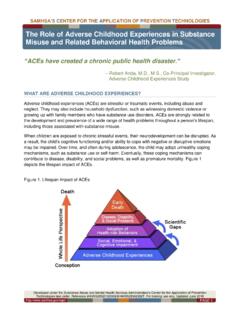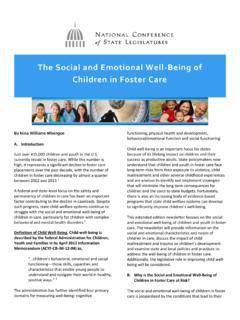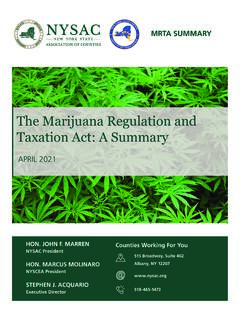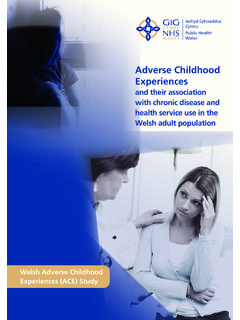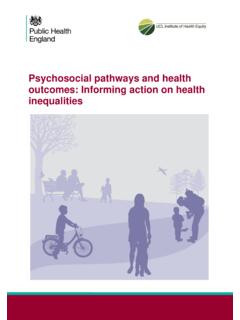Transcription of Understanding and Quantifying Vulnerability in Childhood
1 No child left behind Understanding and Quantifying Vulnerability No child left behind: Understanding and Quantifying Vulnerability 2 About Public Health England Public Health England exists to protect and improve the nation s health and wellbeing and reduce health inequalities. We do this through world-leading science, research, knowledge and intelligence, advocacy, partnerships and the delivery of specialist public health services. We are an executive agency of the Department of Health and Social Care, and a distinct delivery organisation with operational autonomy. We provide government, local government, the NHS, Parliament, industry and the public with evidence-based professional, scientific and delivery expertise and support. Public Health England Wellington House 133-155 Waterloo Road London SE1 8UG Tel: 020 7654 8000 Twitter: @PHE_uk Facebook: Crown copyright 2020 You may re-use this information (excluding logos) free of charge in any format or medium, under the terms of the Open Government Licence To view this licence, visit OGL.
2 Where we have identified any third-party copyright information you will need to obtain permission from the copyright holders concerned. Published September 2020 PHE publications PHE supports the UN gateway number: GW-1202 Sustainable Development Goals No child left behind: Understanding and Quantifying Vulnerability 3 Contents About Public Health England 2 Executive summary 4 What do we mean by Vulnerability ? 6 Quantifying the number of vulnerable children 8 Children in care 8 Young carers 9 Teenage pregnancy 10 Children in the criminal justice system 10 Violence and serious violence 10 smoking , alcohol and drug use 11 Housing 12 Access to outdoor play areas and green spaces 12 Worklessness 12 Poverty 13 adverse Childhood experiences 13 Conclusions 16 Glossary 17 References 20 No child left behind: Understanding and Quantifying Vulnerability 4 Executive summary This report is intended for leaders and practitioners nationally, regionally and locally concerned with improving outcomes for children and young people.
3 It aims to support directors of public health, working with their local partners, to inform coordinated approaches to reduce the number of children who are vulnerable to poor health and wellbeing and to take action to mitigate risks of poor outcomes. It will be of interest to integrated care systems in planning services which are preventive and protective. For the purposes of this report, vulnerable children are defined as any children at greater risk of experiencing physical or emotional harm and/ or experiencing poor outcomes because of one or more factors in their lives. The COVID-19 pandemic raises specific considerations which can be usefully understood in the broader context of Childhood Vulnerability . Current research suggests that, while children of all ages have been diagnosed with COVID-19, symptoms are generally mild and death very rare (1).
4 PHE, NHS England and partners have developed a framework for Vulnerability to support child and young person-centred recovery for 3 broad groups which are: a group of children that may be more clinically vulnerable to COVID-19 because they have underlying health conditions or the pandemic has in some way delayed or curtailed their access to health services children and families who are at increased risk due to family and socially circumstances where there is a statutory entitlement for care and support (education, health and care plan and those with a social worker) children who may be at higher risk due to being negatively impacted through wider determinants of health and/or family stressors family and social circumstances and may not be known to services Children may be in more than one group and children not previously identified as vulnerable may have become so as the economic and social impact of the pandemic are felt in the family.
5 Studies also indicate that children and young people are being affected by the changes the pandemic has brought to their lives, including to their education, time with family and to their emotional health and wellbeing (2). More generally, the underlying wider community and social conditions which can make children more vulnerable which existed before the pandemic are likely to remain; these are the focus of this report. No child left behind: Understanding and Quantifying Vulnerability 5 In this report, we summarise: the extent and nature of Vulnerability in Childhood the evidence of increased risk and impact, associated with factors at individual, family and community levels the protective factors which, where present, can mean that children go on to prosper even where they experience Vulnerability or adversity Alongside this report, No child left a public health informed approach to improving outcomes for vulnerable children describes PHE s actions and resources to improve outcomes for children, young people and their families and how the work of public health and its partners can help children realise their full potential.
6 A narrative report on improving health outcomes for vulnerable children and young people is also available for each upper tier local authority, which gives an overview of relevant local data on risk and protective factors for children and young people which can be used to inform local planning and prioritisation. No child left behind: Understanding and Quantifying Vulnerability 6 What do we mean by Vulnerability ? There is no commonly used definition of Childhood Vulnerability (3). A child can be vulnerable to risks and poor outcomes because of individual characteristics; the impact of action or inaction by other people; and their physical and social environment. Additional factors include: the child s physical, emotional, health and educational needs any harm the child has experienced or may be at risk of experiencing these can include a specific set of Childhood experiences known as adverse Childhood experiences the capability of the child s carers and wider family environment to meet the child s needs, or indeed to cause harm these might include homelessness or poor housing conditions, the presence of adults in the home with mental health problems, alcohol and drug dependence, or contact with the criminal justice system, domestic abuse and poverty the absence of supportive relationships in a child s life the wider community and social conditions beyond the family including crime, the built environment, community cohesion and resilience This list is not exhaustive.
7 And children can experience one or several of these factors with different levels of consequences over the course of their lives including into adulthood. For the purposes of this report, vulnerable children are defined as any children at greater risk of experiencing physical or emotional harm and/or experiencing poor outcomes because of one or more factors in their lives. Some vulnerable children may also have adverse Childhood experiences. These are a specific set of Childhood experiences associated with negative outcomes in later life. Like other factors which make children more vulnerable, they do not inevitably lead to poorer outcomes, but their presence increases the risk of this happening. The potential way in which the COVID-19 pandemic may have affected the Vulnerability of children can be categorised into 3 groups (figure 1) which are: a group of children who may be more clinically vulnerable to COVID-19 because they have underlying health conditions, or the pandemic has in some way delayed or curtailed their access to health services children and families who are at increased risk due to family and socially circumstances where there is a statutory entitlement for care and support (education, health and care plan and those with a social worker) No child left behind.
8 Understanding and Quantifying Vulnerability 7 children who may be at higher risk due to being negatively impacted through wider determinants of health and/or family stressors and social circumstances and may not be known to services Figure 1: Childhood Vulnerability and COVID-19 Source: PHE No child left behind: Understanding and Quantifying Vulnerability 8 Quantifying the number of vulnerable children Children are exposed to a range of factors which make them more vulnerable to poorer outcomes. Children may fall into more than one group so, for example, some children living in homes where there is adult alcohol dependency may also experience domestic violence. This makes it difficult to offer exact figures on the number of children affected but the Office of the Children s Commissioner has estimated that overall there are million children growing up with a vulnerable background, each of whom may have one or more risk factors (4).
9 Some groups of children are more likely to be vulnerable than others, often because of other risk factors. The Office of the Children s Commissioner categorised groups of vulnerable children into 9 domains based on the type of Vulnerability which are: safeguarding concerns or in local authority care health and/or disability economic circumstances family circumstances and characteristics educational engagement involvement in offending and/or anti-social behaviour experience of abuse and exploitation and missing and absent children and minority populations (5) Children in care Of the 12 million children living in England just over 400,000 (3%) are in the social care system at any one time. More than 75,000 of these children are children in care (6). There were 399,500 children classified by social services as being in need at 31 March 2018, while the number of child protection plans at 31 March was 52,300 (7).
10 Many children in care are likely to have had experiences or been brought up in circumstances which make them more vulnerable and at risk of poorer outcomes than other children. Studies have found that children in care are more likely to have lower educational attainment across all age groups as well as poorer mental and physical health (8). They are almost 4 times more likely to have a special education need than the child population overall (9). A review of national and international research on teenage pregnancy suggests that those in or leaving care are more likely to become teenage parents (10). There is also an association between children in care and offending, with No child left behind: Understanding and Quantifying Vulnerability 9 38% of children in Young Offender Institutions and 52% in Secure Training Centres having previously been in care (11).










